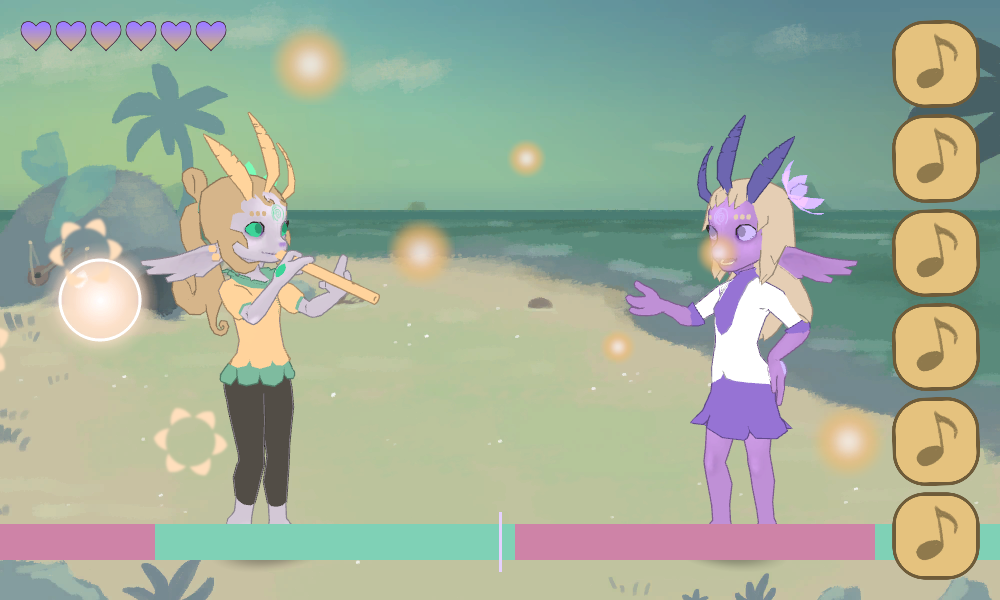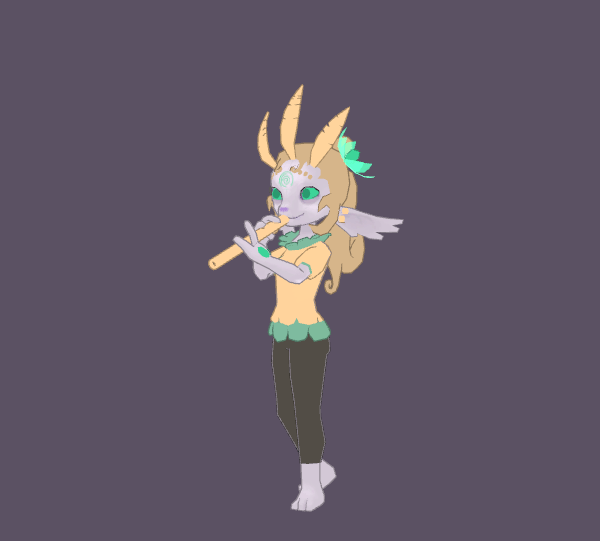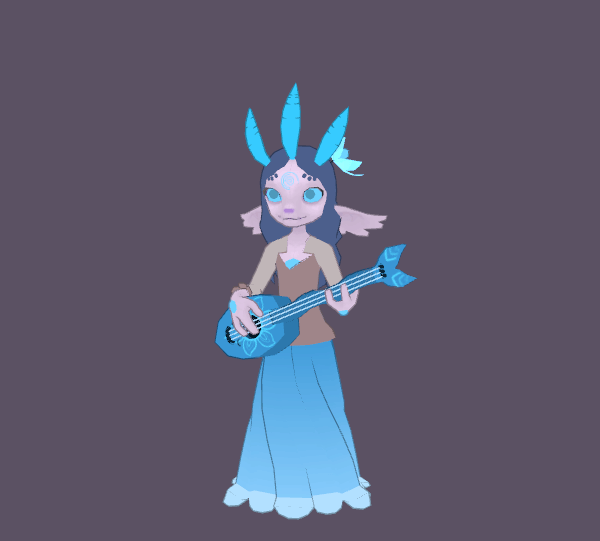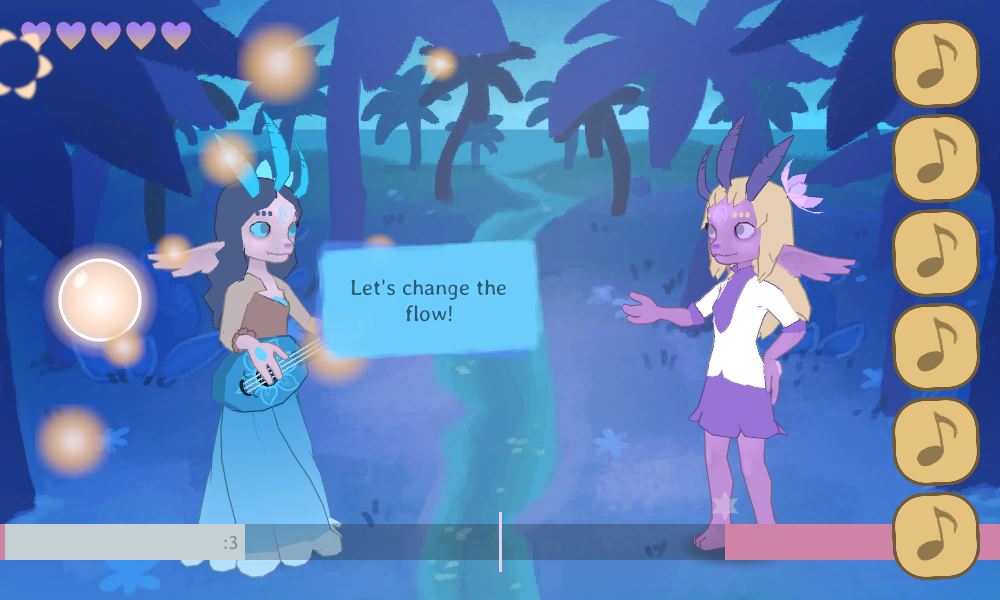PERSONAL
3,097
Sindrel Song - Stages 4 and 5!
5 years ago
Gasp. I'm almost finished with this thing, thanks to working with unusual focus on it all week.
Since I'm trying to make these posts more focused, I won't go into detail about the various personal problems plaguing me these past few days. The most important thing is that I'm recovering steadily from all the brain stuff, or at least enough to spend several hours a day working on this. I've still been a bit of a mess - sleeping for hours in the middle of the day, hit by deep depression, things like that - but I wasn't exactly expecting the road to recovery to be a smooth one.
Anyway, this thing! I've been making quite rapid progress, finishing a level a day, which includes the character model, background, and converting the music I composed last month into the text format the game can read. Alongside that, I've also added and tweaked a bunch of features to improve playability, which almost make it into a different game than it was just a few days ago. Before I describe it in words, here's a video of Melody's stage (the fourth one) to give you an idea of what I mean:
(And here's the preview image:)
![]()
Melody likes hearing rainbows (metaphorically). Maybe she mentioned that's why she's here, somewhere in there. It was probably quite subtle and easily missed though.
The most obvious thing is that there are visuals for the notes now. This makes it more like usual music/rhythm games, in a sense, but it's still not like them in that it's not a
reaction game; that is, you don't see the visuals
before you make the notes, so they serve as feedback or guides rather than explicit targets as such. I mean, you see the other character's visuals before you sing your notes, and it does help to see them in some clear 'notation' form like that - it's been helping me a lot as I play through these increasingly difficult stages - but you still need to rely on a sense of the actual
music, which is what I want this game to focus on. I've said it before, probably more than once, but the main aim is to make an experience that's actually focused on music as music rather than just being a reaction game where music happens to play alongside the main, visually-oriented gameplay.
How people will react to this, I don't know, but I'm personally finding it really enjoyable and alluring to play. I keep coming back to the stages again and again, multiple times in a row even, and it's definitely more fun playing along with them than it is watching them in these videos. Repetition, for example, becomes a chance for easier, pleasing success as a result of familiarity and practice, rather than a source of possible boredom as when just watching.
Some other additions: there are now explicit checkpoints (the stars above the bar) which you return to if you mess up, and the process of messing up is cleaner too. That took way too long to get right, programming-wise. Hours! The way this game has developed, in a very much figuring-it-out-as-I-go-along kind of way, has produced a lot of 'spaghetti code' with redundant variables and arcane, tangled processes, which I'd very much like to refine and streamline, though it's a daunting prospect. Adding new features to it is a bit of a nightmare, but the important thing is that it works! Mostly. I think there might be some subtle issues with the pad notes I've yet to correct, but I'll get to them in time.
Oh, and the note buttons shake in two different ways: they jiggle a bit when the other character plays that note (though the visual indicator emerges as well anyway, so it's a bit redundant now), and they briefly move to the left to show the
first note of the upcoming melody, just before it begins. I found from playing that I often forgot which note I was meant to start on, and this helped a lot (once I got used to it, anyway). There's an issue where it doesn't activate when transitioning from an empty bar to a duet, which is the place it's needed most really, so I'll need to fix that at some point.
I've been watching my own emotional and psychological reactions as I play through the levels, and it's interesting. At first, I'm awful at them, failing repeatedly and taking multiple attempts to finally get through to the end. I'm alert and focused on each pattern, and very aware when I make a mistake, or I get somewhat frantic when I feel unable to mimic as well as I'd like, but it's a kind of excited stress rather than frustration. I also notice that my hands sweat and I almost become trembly; this was especially the case during the duet at the end of this stage, where I felt somewhat confident of having learned the melodies, but not enough to not have to try hard. And it was incredibly satisfying to survive the several minutes of buildup before that bit, then to sing my notes and see them matching (roughly) the ring-shaped notes of the other character. Very fulfilling. The more I played, though, the more the melody mimicking was transferred to procedural memory, and was handled by a different part of the brain, such that I executed them fairly effortlessly with few mistakes, while able to pay attention to other things that I couldn't afford to focus on before, like the lyrics. That's how learning skills works, after all; there's this initial period of accumulation and acclimitisation, which is difficult and stressful and relies heavily on conscious attention, followed by the 'just like riding a bike' stage where it become second nature, handled by entirely different mental processes mostly outside of conscious awareness (it goes unconscious incompetence -> conscious incompetence -> conscious competence -> unconscious competence). Hopefully players will stick with this for long enough to get through the learning stage and to the stage of relative mastery. But we'll see.
(My playing of Melody's level is embarrassingly sloppy, since it's way more difficult than the other two and I've not practised it many times, but I thought I'd leave it as it is for the video to give an idea of how a non-virtuoso player might play the game.)
I'm concerned that with all these new additions, the whole experience is becoming overcrowded, and I'm losing a lot of the simplicity I was aiming for in the beginning... but it's all very much a work in progress and everything is subject to change according to what seems best, so I don't know how much this reflects what the final experience will be.
I've got so far with this though that it's far more likely than not that there will
be a final experience, a finished game at the end, so that's a good thing!!
![]()
The two new characters this time around are both female. I thought at first I should alternate the genders, so female-male-female-male-female-male, but they're arranged as they are now (female-male-male-female-female-male) in an order that seems the most sensible to me based on the themes the characters explore and the difficulty of their stages, rather than just meeting a contrived gender pattern. How interesting.
This one is Melody:
![]()
The most remarkable features of her designs are the incorporation of both the
∞ treble ('G') and bass ('F') clefs ∞ into her hair; her ponytail is styled after a treble clef, and the bits on the side are bass clefs, with ear studs for the two dots. I quite like that. It's cartoonishly impractical of course, but that's part of the appeal. The rest is fairly plain and unremarkable, and her skin isn't as white as it should be here.
Also, I've been using a shared base sindrel model for all of these characters (well, two, one for males and one for females), and just modelling clothes, hair and instruments on top of them, which is why I'm able to make them so fast. The naked base model still exists under the clothing though, and outlines are drawn for it because of the shader it's using. Normally these outlines aren't visible, but they are for Melody's legs because her pants are quite tight against the skin. Since the outlines have their colour calculated by the model's texture, this means that her legs appear to have a light outline rather than a dark one as they should. I eventually intend to merge the clothes and base model into a separate model for each character, without hidden faces, later on, to fix this. I might also tweak facial features for each character when I do that, though I'm not sure yet. This is the kind of trivial, technical stuff I have to worry about as the designer, that players wouldn't really focus on, notice, or care about.
Oh, and Melody represents the Jolly rune/trait. She's one of the first that Hearth saved from the deadly winter, but she used to pride herself on her voice, and was quite upset when she lost it (as all the females did not long after their six days were up). Rather than dwelling in despair, though, she created instruments for herself and the other sindrels so then they could still produce music despite what they'd lost. Her flute is simple, because it's the first instrument she made. She feels that life is empty without music, and it's interesting having a character like that in a game based on music like this.
(Sindrels talk using telepathy, which is why they can talk while playing a flute and without moving their mouths, and why they can 'lose their voice' but not their ability to speak. It also kind of fits with the idea of there being 'lyrics' which aren't actually audibly sung.)
The other character is Course, who I've mentioned before:
![]()
She was intended to represent the Realistic trait, to be someone who'd been firmly rooted in the normal, traditional course of sindrel life, the mainstream, such that now that she's outside of that, she's lost and full of doubt about whether she made the right choice. Originally I meant for her to be quite motherly, because her life was about reproduction but she's been unable to reproduce because she hasn't died, but design-wise she didn't really turn out that way; she looks more serene and regal or something to me.
She's also quite agreeable, and says 'yes' (or 'of course') to opportunities, which is why she said yes to Hearth offering her a different path than the one which led to death.
As for design remarks: she has rivers as a motif, so her dress is meant to be reminiscent of those, as is her hair (which should really look wavier; I might edit that). She has an arrow design on her chest, because it suggests direction (a 'course'). From her perspective, it's pointing her forward, and from others' perspective, it's pointing to her chest gem, which hints at the original idea of her being focused around motherhood. She has a 'guitar' which isn't especially inspired design-wise, but it'll do, I suppose. It's got a wavy neck (or whatever that bit of a guitar is called... maybe it's called the 'fondle shaft'), an aster design, and the are some
∞ consummate U's ∞ which look kind of like a relaxed face and also fish scales. It bothers me that the guitar is floating, without a strap to hold it up; maybe I'll add one later.
I haven't actually finished playing through Course's stage yet; it's quite tough, and I've been so tired today. I wonder how much I'll have to tweak the difficulty when other people have a go and give feedback.
![]()
But yes, it's nice to be making good progress rather than just lying around ill all the time! I mean, I'm doing that
too, but I'm not wasting
all my time anymore, so that's an improvement!
I've only got one more character to do (Hearth), but I'll need to do a lot of tweaking after that. Ideally I should start play testing soon too, if you're interested in that... I'll write another post specifically about it soon.









0